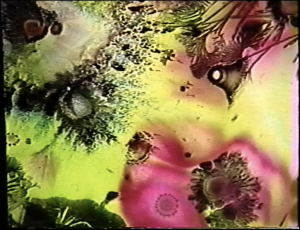Electronic music video and audio recordings by Dr. Otto Henry
STAFF PICK: Electronic music video and audio recordings by Dr. Otto Henry
STAFF PERSONS: Justin Borer and Alston Cobourn
COLLECTIONS: Otto Henry Papers, UA90-64, University Archives
In 1968, Dr. Otto Henry moved to Greenville, North Carolina for a teaching position in the East Carolina School of Music. Upon his arrival, he established the school’s Electronic Music Composition and Ethnomusicology programs as well as its Recording and Electronic Music Studio. A prolific composer for over three decades, some of his pieces, such The Time Machine, The Valley of Spiders, and The Crystal Egg, were inspired by the writings of H.G. Wells, who is frequently credited as the father of science fiction.

Still image from Dr. Henry’s video recordings.
Because Dr. Henry began composing in a time when computer music was theoretical, and consumer electronic music instruments did not exist, he built his instruments by hand from spare electronic parts, deconstructed radios, or kits ordered through the mail. Experimentation was a key creative process for composers working with electronic music and incorporation of multimedia aided in the development of a new way to create music, the creation of a space where man and machines played together, sometimes letting the machine play on its own. This idea, which modern musicians use regularly, was still only a few decades old when Dr. Henry began incorporating electronics into music. At that time, it was very futuristic.
He was able to employ many new techniques through the incorporation of technology into his music making, such as playing back pre-recorded material on reel to reel, often very highly edited and spliced, during a musical performance; putting microphones near amplified speakers to create feedback on purpose; and letting electronic oscillators hold notes within pitches for longer durations than one could play on normal acoustic instruments. Eventually his compositions included more complex processes such as accompanying visual media projections and the creation of new electronic sound textures and rhythms used with performances by modern dance ensembles.

Still image from Dr. Henry’s video recordings.
While Dr. Henry had contemporaries of the time, what makes him particularly interesting and important is that he was doing this work in Greenville, North Carolina, a hidden gem away from the larger cities, institutions, and personalities around the world that were more highly funded and more widely re cognized. He taught these techniques to students in an approachable way so they could use them in their own music creations, normalizing a once futuristic idea of how music could be perceived and changing the landscape of what music would become. It is important to note that Dr. Henry never had his recorded electronic works published and his generous donation of his life’s work resides at ECU in our main library. This is truly a buried treasure of early electronic and computer music and shows the breadth of his work from experimentation to formal composition.
You can enjoy 11 of his digitized videos in our Digital Collections including “Video recording: “Otto Henry: Electronic Music with Intermedia, 1963-1978”, which contains electronic music pieces made with multiple techniques and a presentation by Dr. Henry himself describing his processes. Many audio recordings of his compositions, in both traditional and experimental styles, are also available online. These items date from the 1970s, 1980s, and 1990s.

Still image from Dr. Henry’s video recordings.
His collection also contains original musical scores and instructions for performance art pieces, correspondence related to ECU’s Electronic Music Studio and with electronic music pioneer Robert Moog, promotional materials for early electronic music equipment and kits, concert programs, notes from courses taught and taken, research materials for his book “Ringing Bells in Malta,” and memoirs about his military service. View our collection guide to learn more about the collection, see a list of its contents, and make an appointment to come see the materials in person or use them in your own research!